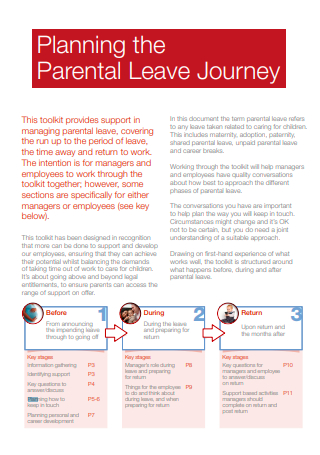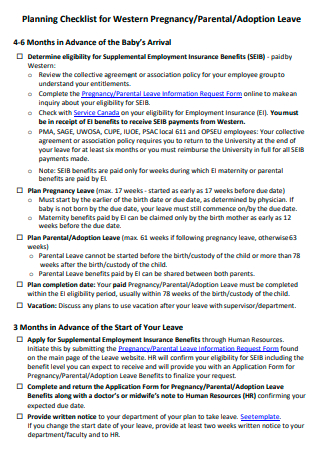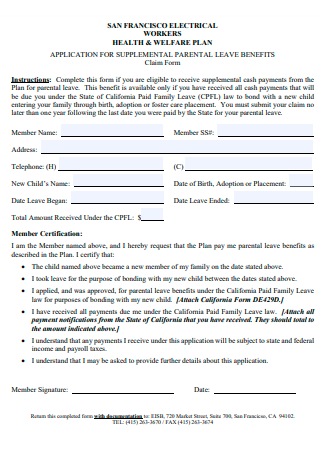3+ Sample Parental Leave Plan
FREE Parental Leave Plan s to Download
What Is a Parental Leave Plan?
Parental leave is a perk available to employees in nearly all countries. The word “parental leave” can refer to maternity, paternity, and adoption leave, or it can be used apart from “maternity leave” and “paternity leave” to denote family leave available to any parent to care for young children. In certain nations and jurisdictions, “family leave” encompasses time off to care for unwell family members. Frequently, minimum benefits and qualifying restrictions are mandated by law. Twenty-five percent of companies provide paid parental leave to at least some employees for the birth or placement of a child, according to statistics.
Benefits of Paid Parental Leave
Thankfully, times are changing, and paid family leave is becoming more prevalent. In nine states, family or paid parental leave is compulsory. Additionally, many U.S.-based businesses are adopting parental leave plans with pay. Paid family leave benefits firms and employees in five significant ways:
Retention of Employees are Improved: Turnover affects profitability. According to American Progress, replacing an employee costs an average of 21 percent of their base wage. According to the Department of Economics at American University, close to 30 percent of working women leave the job force within one year after having a child. However, paid parental leave policies encourage employees to return to work, thereby maintaining talent for businesses. According to a study, states with paid parental leave legislation saw a 20 percent decrease in the number of female employees quitting their jobs within a year of the birth of their child. After five years, this number will have decreased by 50 percent.Attract and Retain New Talent: Companies who give paid parental leave to their employees profit from talent retention and attraction. In a 2014 poll of highly educated U.S. working fathers, 90% said it would be vital for a prospective employer to give paid parental leave, and 60% said it would be “essential.” Every perk supplied as part of the employee value proposition matters in a competitive market.Enhance productivity and employee morale: Employees who work after a leave have a sense of employment security and job satisfaction. Job satisfaction is associated with greater staff productivity and confidence. Also, given that so many workers are parents and those who aren’t may become parents in the future, knowing that parental leave is available gives them peace of mind.Improve parents’ and children’s mental health and well-being: It isn’t easy to choose between working and being a parent. When parents have the choice to take paid leave to care for their children, they do not have to worry about obtaining childcare or worrying about their sick child when they cannot be with them. Parental leave can also positively affect the children’s well-being and mental health. Parental leave policies give fathers and mothers equal opportunities to bond with their children. When employees can take paid family leave, children do not have to be separated from their parents during the first months of life, during significant occasions, or when they are ill. Paid parental leave for fathers is related to greater father-child attachment and involvement. Children’s improved health and development outcomes can result from increased bonding and engagement. One survey revealed seven out of ten fathers only took ten days or less of parental leave.Increased private and public investment: Paid parental leave programs favorably affect the economy and society. Paid family leave can also lessen racial inequities in minority populations’ pay loss. According to studies, additional health benefits for parents who have the time to care for their child after birth include lower baby hospitalization rates and excellent mother health. Parental leave enhances public health by enabling parents to care for themselves and their children, minimizing disease spread, and strengthening mental health.
Types of Employee Leaves
A leave policy assists you in defining the number of leaves your employees are entitled to, the categories of leaves for which they are qualified, and the application process. With a leave policy, you can reassure them that you will offer them the necessary time off to address any concerns or take a vacation, recover from an illness, celebrate holidays, deal with life events, or rest. Here are ten sorts of leaves that your leave policy must accommodate:
Sick leave: Sick leave is time off that an employer gives employees so they can get better from being ill and take care of their health. Sick days are critical because they let people get the rest they need without worrying about losing pay. Employees must take sick leave in many countries to ensure they stay healthy. Companies have to give their workers 15 days of sick leave each year. But you also need to be flexible with sick days and let people take longer ones if they have serious health problems. In many companies, sick days that aren’t used by the end of the year can be carried over to the following year. But you must tell unhappy employees to take the day off.Casual leave: Employees take casual leave for travel, vacation, rest, and family obligations. Such breaks allow the employee to take time off for significant life events, such as attending a wedding or traveling to another nation. Providing the employee with paid time off will allow them to prioritize their personal life when necessary and make them feel valued by the organization. In most companies, employees are permitted between 8 and 15 days of unscheduled leave per year.Public holiday: Public holidays are considered government-granted leaves. Every institution must respect these holidays, including schools, banks, government offices, and private businesses. Independence Day, Memorial Day, Labor Day, bank holidays, and any nationally-recognized day, such as the death of a renowned leader, are examples of public holidays. Include these leaves within your leave policy by researching the government-mandated holidays in your country.Religious holidays: Christmas, Eid, Easter, Holi, and Yom Kippur are all your employees likely to celebrate and would desire the day off to spend with their family and observe the celebration. You must accommodate these holidays by allowing employees to take time off on the festival day. Take note of every religious holiday from online resources and request that employees send you an annual message identifying the religious holidays for which they require time off.Maternity leave: From caring for the infant to recovering from childbirth, maternity leave is a crucial period for new mothers. Ensure that your policy accommodates this type of leave so that staff can focus on their newborns without worrying about their jobs. The new mother is granted 7 and 17 weeks of maternity leave, depending on the company’s home nation. Fourteen weeks is a sufficient length of time to offer the mother so that she can care for her infant for the first three months. It will help if you’re willing to provide additional leave days in the event of postnatal difficulties.Paternity leave: New fathers—husbands or partners of a pregnant woman, surrogate parents, or adoptive parents—are offered paternity leave to care for their newborns without anxiety. Unlike maternity leaves, new fathers often receive two weeks of paternity leave after the birth of their kids. Some countries require new fathers to take one to two weeks of paternity leave. Since such vacations are not mandated by law, employers rarely offer paternity leave upon the birth of a child. However, human resources must acknowledge the challenges associated with adjusting to a newborn and caring for a child in the initial few days.Bereavement leave: In unavoidable situations like the death of a loved one, employees take unannounced absences. As HR, you must create a bereavement leave policy that allows employees to grieve their loss, manage any duties they may have resulting from the death, and request bereavement leave without difficulty. Depending on the deceased relative’s proximity, most human resources departments grant their employees between 3 and 7 days of bereavement vacation. If you are unsure how to design a policy for bereavement leave, you can read our guidance.Compensatory leave: Employees who have worked beyond their necessary hours may be eligible for compensatory time off. Ensure that any employee who worked extra hours or came in on days off receives a “comp off” or compensating day out. Compensatory time-off must be recorded in your backend system, and employees must be notified that they have earned an additional day of leave.Sabbatical leave: Sabbatical leaves are “a vacation from work” during which employees can pursue personal hobbies or take time off for physical or mental health causes. Unlike other leaves, sabbaticals range from six to twelve months in length. Sabbaticals are frequently taken by employees at educational institutions, where professors may wish to take a vacation from teaching to do research. Companies that have employed staff for more than three years grant them sabbaticals as a reward for their dedication and commitment.Unpaid Leave: Now, if an employee has exhausted their leave eligibility and is taking a leave that is not covered by unique leaves such as maternity or bereavement leave, they may still take a leave with a pay reduction. The employee’s income will be reduced for any leaves taken during the year that are not paid. Ensure that the employee knows the number of leaves available to them and the amount of pay that will be withheld for each day of leave taken outside of their eligible leaves.
How To Write a Parental Leave Letter
Documenting your parental leave in writing is essential so your boss may make arrangements to manage your task in your absence. Traditionally, maternity leave, also known as primary caregiver leave, applies to the birthing parent, whereas paternity leave is requested by non-birthing parents, sometimes referred to as secondary carers. This term is also commonly used by adoptive parents. As soon as you identify how extended your leave of absence will be and when you’ll be taking it, it’s generally a good idea to discuss this information with your employer. Here are the guidelines for creating a formal letter of parental leave.
1. Include the date and your address with correct formatting
Place your address in the upper left-hand corner of your letter. As with all formal letters, skip a line before including the date. Also. Add the business address of your supervisor one line beneath the date. Even if you have a casual working relationship with your boss, you should use a formal greeting and address them correctly. For instance, you could write, “Dear Mr./Ms.
2. Justify your motive for writing
In the introductory part of your letter, state why you are writing and how long you anticipate being away on parental leave. You should also indicate the particular dates of your departure and return. You may also suggest working from home before or after these dates to see whether your employer is amenable to the idea.
3. Provide a proposed workload
In the following paragraph, offer a plan for covering your workload while you are absent from the workplace. Be forthright when discussing work you believe you will be unable to finish and work that must be performed while you are on vacation. Define where you are or will be with short-term or long-term projects when you leave if you are responsible for them. In your absence, provide recommendations for who you believe is most capable of advancing specific tasks.
4. Set communication expectations
In the final paragraph, inform your manager of your planned amount of communication throughout the parental leave. Inform them if you intend to ignore your work email while your absence altogether. If you want to work while on vacation, communicate how regularly or infrequently you intend to check in. According to studies on workplace communication, 86 percent of employees and executives attribute company failures to ineffective collaboration and communication. Conversely, teams with excellent communication may enhance their output by up to 25 percent.
5. Include a transition plan and express your gratitude
If you anticipate that your work schedule may need to be altered upon your return to work, you could also mention that information in the final paragraph. If you are uncertain, you may wish to wait and make a decision later. Also, convey your sincere appreciation for your employer’s understanding as you took time off to care for your newborn. It is essential to express gratitude for their knowledge adequately. If you are handing a hard copy of your letter to your supervisor, it is preferable to include both your handwritten and typed signatures. You can type your name while sending an email.
FAQs
What is a leave request?
A leave application letter is written to request a specified leave time from the office. The concept of a leave application revolves around a formal request for a specific time off from work.
What is annual leave plan?
Annual leave is the time, occurring once a year, during which an employee may use accrued paid leave to request a lengthy leave. Annual leave is computed in addition to national holidays, casual, sick, and maternity or paternity leave for employees.
What is leave balance?
A leave balance is the amount of accrued leave in the system for an employee’s specific leave category. When a leave category is allocated to an employee, leave accrues by the settings established in Config > Leave.
Globally, parental leave entitlements differ. Some nations define parental leave as an individual, non-transferable entitlement. Each parent is eligible for a predetermined amount of leave. Others allow one parent to shift their allocated leave to the other. Parental leave may also be characterized as a family right, allowing parents to divide the overall leave time at will. Additionally, entitlements may include both familial and individual rights. For the sake of engaging in mentally challenging but materially attractive duties, many people do not even enjoy their vacations. Most respondents claim “never” or “I can’t recall” when asked when they last took adequate vacation time. This is why many individuals experience burnout or begin to suffer physically, emotionally, and professionally at work. Avoid this happening to you. Take some time off to relax and restore your energy. It is essential.




